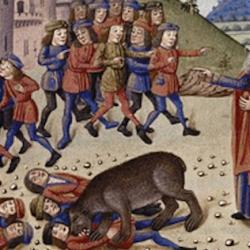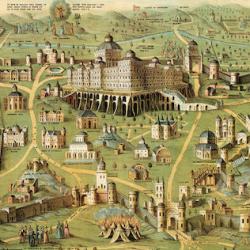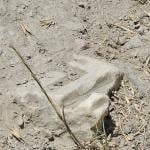INTRODUCTION
All cultures draw lines between who is “inside” and who is “outside,” and between different classes of people within the culture. Cultures lift some people up “high” and consider some people “low.” The gospel confounds the boundaries of all worldly cultures, and redraws the lines between those who are “in” and those who are “outside” Christ. In the salvation of Samaria, we see a foreshadowing of the great confounding event of the gospel.
THE TEXT
“And it happened after this that Ben-Hadad king of Syria gathered all his army, and went up and besieged Samaria. And there was a great famine in Samaria; and indeed they besieged it until a donkey’s head was sold for eighty shekels of silver, and one-fourth of a kab of dove droppings for five shekels of silver. Then, as the king of Israel was passing by on the wall, a woman cried out to him, saying, ‘Help, my lord, O king!’ And he said, ‘If the LORD does not help you, where can I find help for you? From the threshing floor or from the winepress?’ . . . .” (2 Kings 6:24-7:20).
CONTEXT
This story of the Aramean war parallels the previous chapter in a number of ways. Both open with a king concerned about the state of his kingdom – the Aramean king worried about moles in his army, the Israelite king observing the barbarism of Samaria during a siege. Both kings blame Elisha for the problems they face, and both kings send soldiers to capture or kill Elisha. In both cases, Elisha provides food – a banquet for his Aramean captives and plunder from the Aramean camp. While the king of Israel can do nothing but tear his clothes at cannibalism, Elisha delivers Samaria from famine.
This episode is also structurally parallel to the Moabite rebellion in chapter 3. The two stories share a number of themes. In both stories, a siege is broke; in both, Elisha prophesies specifically about provisions for Israel. In chapter 3, the Moabite king sacrifices his son on the wall of Kir-hareseth, and in chapter 7 a woman tells the king about killing and eating a child on the wall of Samaria.
The break at chapter 7 makes no sense. Elisha is still sitting with the elders in his house in 7:1 (cf. 6:32), with the messenger from the king of Israel at the door. The oracle in 7:1 is Elisha’s response to the question of 6:33. But there is a gap in the story. 7:2 introduces a character that has not been mentioned, and implies that Elisha is delivering his oracle to the king himself (cf. 6:32). Verse 17 confirms that this is the case. Yet, the king’s arrival to Elisha’s house is never explicitly mentioned, perhaps a sign of his utter subordination to Elisha. When they come before a prophet, kings have no right to make a grand entrance. (Notice the parallel of 2 Kings 6:32 and 1Kings 14:6).
To get the full structure, you have to include 8:1-6, which is parallel to 6:24-31 (both deal with famine, both have a woman crying out to a king for redress of a grievance, both refer to children, and in both Elisha is mentioned but does not appear). Within this parallel is a sharp contrast in the action of the king. The king tears his garments when he’s on the wall, but he gives justice to the Shunammite. In 8:1-6, further, the king seems again to be favorable to Elisha, listening to stories of his exploits. In place of the official of 7:1-2, we have Gehazi, the leper, standing before the king. He has fully taken over the role of Naaman, as a member of the king’s entourage Overall, the story is structured as follows:
A. King’s impotence: woman’s appeal; king wants to kill Elisha, 6:24-31
B. Elisha’s prophecy, 6:25-7:2
C. Four lepers discover the camp: plunder it, 7:3-8 (if we die, we die)
D. Lepers bring good news, 7:9-10
C. Five horses discover camp: Samaritans plunder the camp, 7:11-16a (if they die, they die)
B. Elisha’s prophecy fulfilled, 7:16b-20
A. King redeems the Shunammite, 8:1-6
SIEGE OF SAMARIA
6:23 tells us that Arameans stopped invading Israel, but in verse 24 we read of Arameans besieging Samaria. Perhaps the events are not in chronological order, or perhaps verse 23 simply means that the Arameans stopped invading with marauding bands. Instead of guerilla warfare, they’ve pulled out all the stops and have begun total war. This siege anticipates the later sieges that will bring an end to Israel’s habitation of the land (cf. Lamentations 2:20; 4:10). Yahweh is tightening the noose.
The king’s faith is unstable. In the previous story, he obeyed Elisha and considered him a “father” (6:21). But now he blames Elisha for the siege, perhaps because thinks that Elisha let the Arameans off too easily. Like Ahab, he thinks that the prophets are the troublers in Israel. The siege has led to famine so severe that donkey heads dove dung are rare treats (v. 25; cf. 2 Kings 18:27). The woman on the wall cries out to the king for “salvation” (v. 26), which in this case means food (v. 27). The king doesn’t know where salvation is found; he should be seeking it from Elisha, whose name means “My God saves.”
The woman who confronts the king on the wall wants the king to judge a case. As Yahweh threatened (Deuteronomy 28:52-57), Israel’s disobedience had led to siege and cannibalism, particularly cannibalism of children, cannibalism of the future. Unlike Solomon, this king of Israel lacks the wisdom to pass a wise judgment in an impossible situation. He can only tear his robe in despair (v. 30; cf. 5:7). The king wants to strike Elisha with a head wound (v. 31), but he’s too late. Elisha’s head, Elijah, has already been taken from him, and is indestructible in the heavens (2 Kgs. 2).
LEPER REDEEMERS
As Jesus said, there are lepers in Israel, but only the Gentile Naaman is cleansed. But here there is yet another reversal: Not only are Gentiles cleansed rather than Jews, but within Israel lepers excluded from the city, rather than the official who stands in the gate, discover and announce the “gospel” of the city’s deliverance and rebirth (v. 9). The reasoning of the lepers anticipates the counsel of Jeremiah during the Babylonian siege: Better to surrender and take our chances with Aram than to starve to death in the city (v. 4).
They begin to feast while those in high places get trampled. So too, Jesus says that the sons of the kingdom will be cast out, and will watch, noses pressed to the window pane, as many from east and west feast with Abraham, Isaac, and Jacob. No wonder the king later welcomes Gehazi to his court (8:1-6); perhaps there’s something to be said for lepers after all. Four lepers provide the ironic cornerstones of a new city.
This deliverance, like Passover and like the later deliverance of Jerusalem (2 Kings 18), takes place at night. Not an angel of death, but the horses and chariots of Yahweh frighten the Arameans (v. 6). Perhaps the Arameans mistook the lepers for attacking soldiers; Yahweh can panic our enemies with a handful of misfits. After Passover, on the evening of a new day (v. 7), the next step it to plunder “Egypt.” Initially, the lepers act like Achans or Gehazis, taking plunder only for themselves and hiding it away (v. 8). Then they think better and share the wealth. As a result, Yahweh has turned Samarian’s famine to feasting, though this turn of events is disastrous for anyone heavily invested in the market for donkey heads and doves’ dung.











